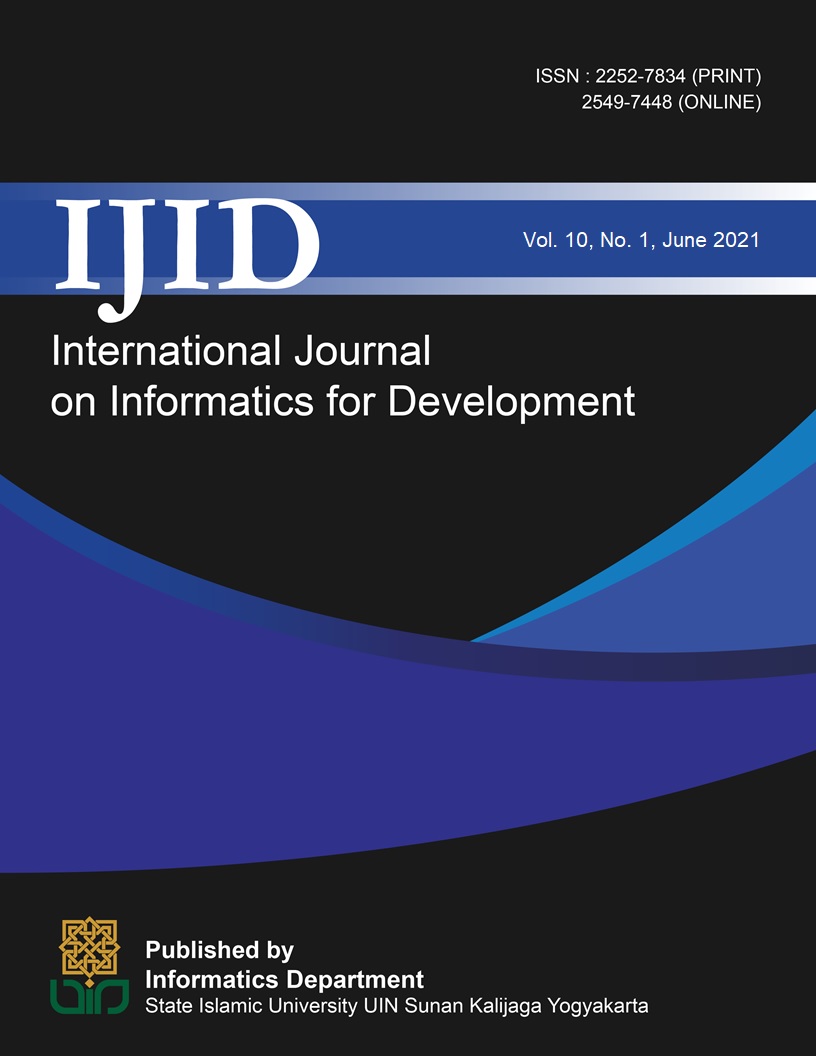Abstract
Twitter is one of the micro-blogging social media which emphasizes the speed of communication. In the 4.0 era, the government also promotes the distribution of information through social media to reach the community from various lines. In previous research, Social Network Analysis was used to see the relationship between actors in a work environment, or as a basis for identifying the application of technology adoption in decision making, whereas no one has used SNA to see trends in people's response to agricultural information. This study aims to see the extent to which information about agriculture reaches the community, as well as to see the community's response to take part in agricultural development. This article also shows the actors who took part in disseminating information. Data was taken on November 13 to 20, 2020 from the Drone Emprit Academic, and was taken limited to 3000 nodes. Then, the measurements of the SNA are represented on the values of Degree Centrality, Betweenness Centrality, Closeness Centrality, and Eigenvector Centrality. @AdrianiLaksmi has the highest value in Eigenvector Centrality and Degree Centrality, he has the greatest role in disseminating information and has many followers among other accounts that spread the same information. While the @RamliRizal account ranks the highest in Betweenness Centrality, who has the most frequently referred information, and the highest Closeness Centrality is owned by the @baigmac account because of the fastest to re-tweet the first information.
References
S. Kumar, F. Morstatter, and H. Liu, Twitter Data Analytics: Introduction. SpringerBriefs in Computer Science., Springer-Verlag New York, pp. 1-3, 2014, doi: 10.1007/978-1-4614-9372-3.
S. N. Diana, “Identifikasi Pengguna Media Sosial Yang Berpengaruh Berdasarkan Graph Dengan Metode Social Network Analysis,” Undergraduate Thesis of Institut Teknologi Sepuluh Nopember (ITS) Surabaya, pp. 112, 2017, [Online]. Available: http://repository.its.ac.id/47695/.
A. Erlansari, “Konsep Visualisasi Data menggunakan Social Network Analysis (SNA),” Seminar Nasional Inovasi, Teknologi dan Aplikasi (SeNITIA), 2018, pp. 119–121.
D. Kurniawan, A. Iriani, and D. Manongga, “Pemanfaatan Social Network Analysis (Sna) Untuk Menganalisis Kolaborasi Karyawan Pada Pt. Arum Mandiri Group,” J. Transform., vol. 17, no. 2, pp. 149, 2020, doi: 10.26623/transformatika.v17i2.1646.
H. C. Simpson and R. C. de Loë, “The agricultural community as a social network in a collaborative, multi-stakeholder problem-solving process,” Water (Switzerland), vol. 9, no. 10, 2017, doi: 10.3390/w9100750.
G. Wang, Q. Lu, and S. C. Capared, “Social network and extension service in farmers’ agricultural technology adoption efficiency,” PLoS One, vol. 15, no. 7 July, pp. 1–14, 2020, doi: 10.1371/journal.pone.0235927.
S. Vishnu, J. Gupta, and S. P. Subash, “Social network structures among the livestock farmers vis a vis calcium supplement technology,” Inf. Process. Agric., vol. 6, no. 1, pp. 170–182, 2019, doi: 10.1016/j.inpa.2018.07.006.
I. Fahmi, “SOCIAL MEDIA ANALYSIS IN ACTION,” 2020, no. November.
I. Fahmi, “Drone Emprit Academic: Software for social media monitoring and analytics.” Available at http://dea.uii.ac.id, 2018.
Y. M. Manik, H. Sutanta, and D. Diyono, “Analyzing Stakeholders and Their Roles in Geospatial Information Utilization in local Government using Social Network Analysis Method,” Semin. Nas. Geomatika 2017 Inov. Teknol. Penyedia Inf. Geospasial untuk Pembang. Berkelanjutan, no. February, 2018.
N. M. Harrigan, G. (Joe) Labianca, and F. Agneessens, “Negative ties and signed graphs research: Stimulating research on dissociative forces in social networks,” Soc. Networks, vol. 60, no. October 2019, pp. 1–10, 2020, doi: 10.1016/j.socnet.2019.09.004.
Home Office, “Social Network Analysis: ‘How to guide,’” no. January, p. 13, 2016, [Online]. Available: https://assets.publishing.service.gov.uk/government/uploads/system/uploads/attachment_data/file/491572/socnet_howto.pdf%0Ahttps://www.gov.uk/government/uploads/system/uploads/attachment_data/file/491572/socnet_howto.pdf.
K. E. Sapountzi, Androniki and Psannis, “Social networking data analysis tools and services,” Soc. Netw. Anal. Contemp. Bus. Organ., pp. 19–34, 2016, doi: 10.4018/978-1-5225-5097-6.ch002.
R. Oktora and A. Alamsyah, “Pola Interaksi Dan Aktor Yang Paling Berperan Pada Event Jgtc 2013 Melalui Media Sosial Twitter (Studi Menggunakan Metode Social Network Analysis),” Jurnal Manajemen Indonesia, vol. 14, no. 3. p. 201, 2017, doi: 10.25124/jmi.v14i3.370.
S. Pomalingo, B. Sugiantoro, and Y. Prayudi, “Data Visualisasi Sebagai Pendukung Investigasi Media Sosial,” Ilkom. Jurnal Ilmiah., vol. 11, no. 2, pp. 143–151, 2019, doi: 10.33096/ilkom.v11i2.443.143-151.
A. M. Pudjajana, D. Manongga, A. Iriani, and H. D. Purnomo, “Identification of influencers in social media using social network analysis (SNA),” 2018 Int. Semin. Res. Inf. Technol. Intell. Syst. ISRITI 2018, pp. 400–404, 2018, doi: 10.1109/ISRITI.2018.8864458.
N. A. W. YOGA, “Kajian Graph Social Network Analysis Untuk Identifikasi Relasi Mahasiswa ITS,” 2017.
M. S. Setatama and D. Tricahyono, Ir., M.M., Ph.D., “Implementasi Social Network Analysis pada Penyebaran Country Branding ‘Wonderful Indonesia,’” Indones. J. Comput., vol. 2, no. 2, p. 91, 2017, doi: 10.21108/indojc.2017.2.2.183.
M. R. Ma’arif, “Intro Social Network Analysis,” Universitas Jenderal Achmad Yani Yogyakarta, 2020.

This work is licensed under a Creative Commons Attribution-NonCommercial-NoDerivatives 4.0 International License.
Copyright (c) 2021 IJID (International Journal on Informatics for Development)
